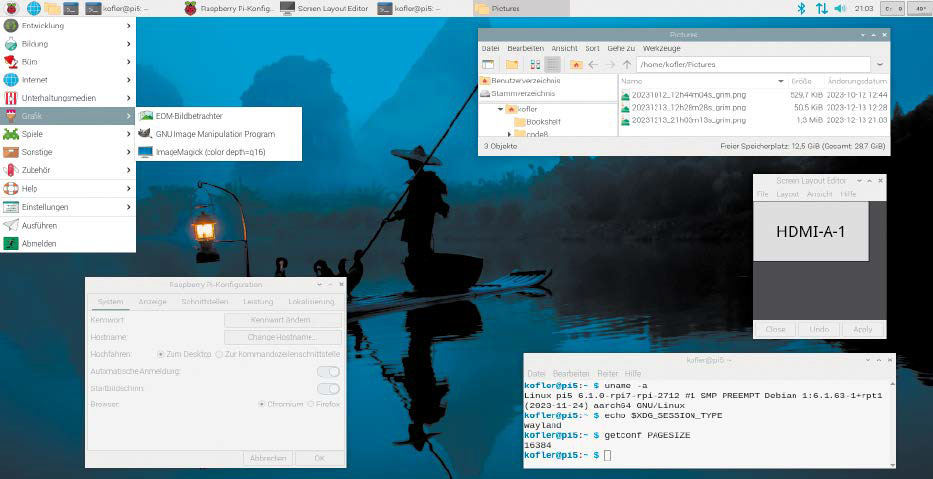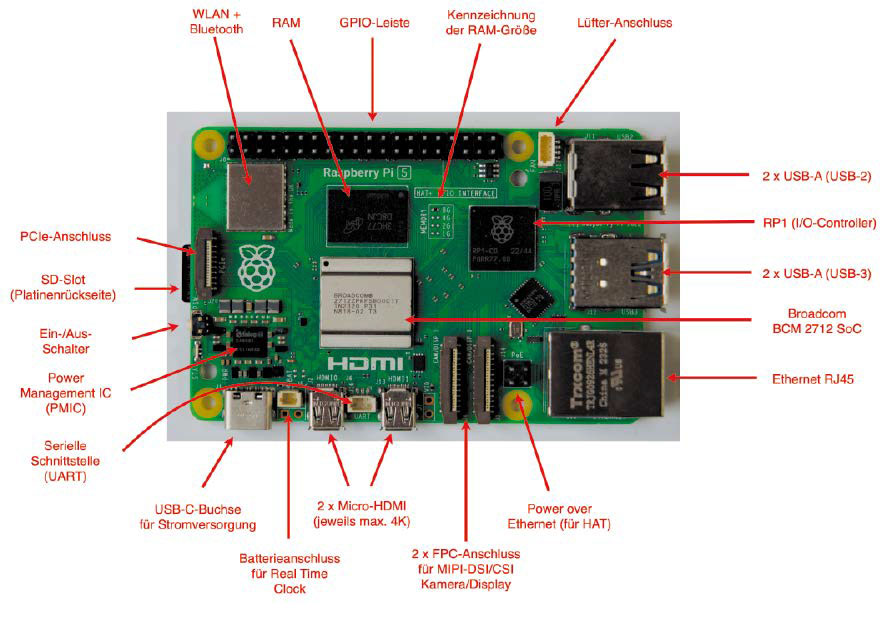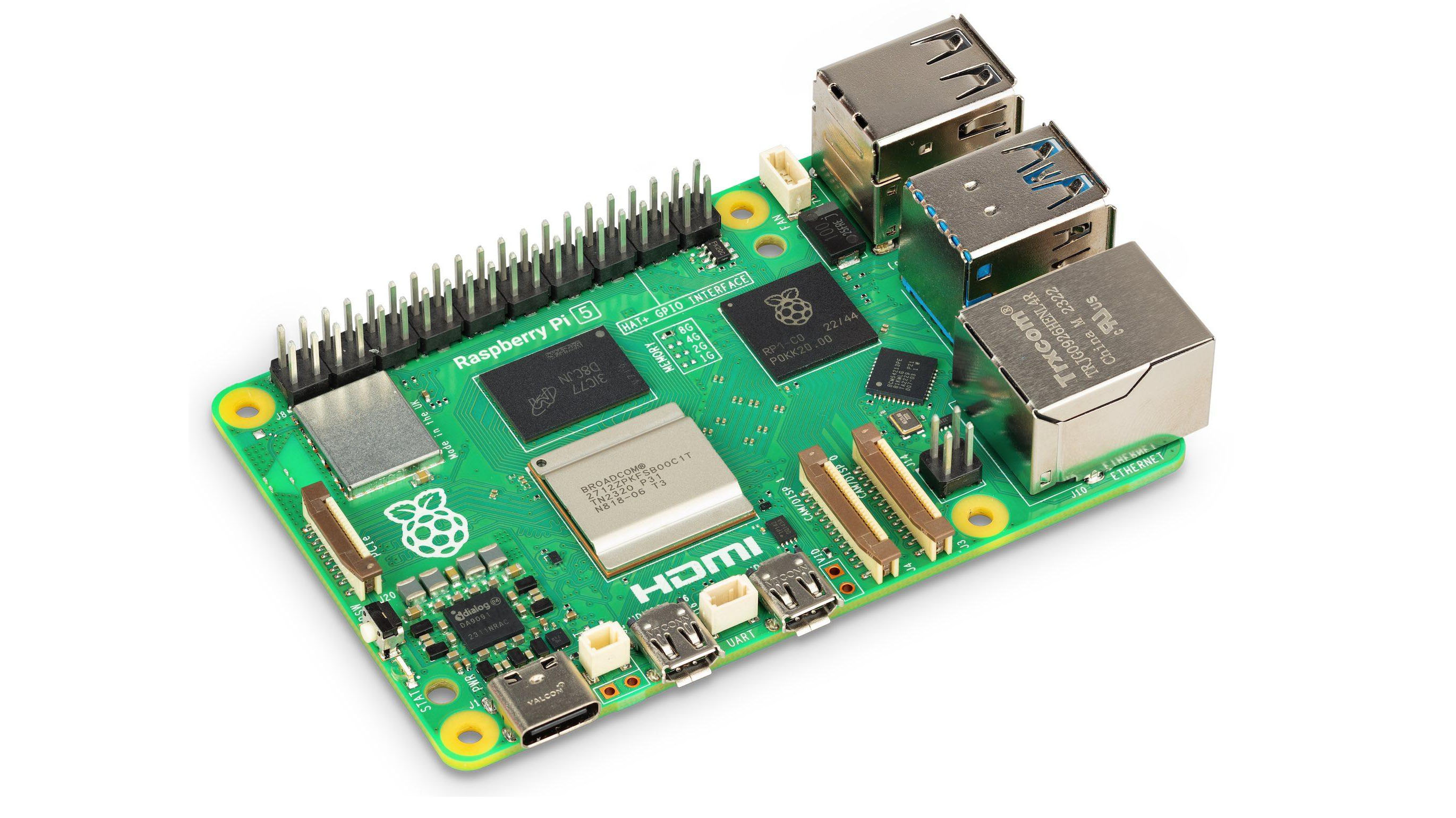The Raspberry Pi dominated the maker scene for a decade. Supply chain problems then brought the high flying to an end. With the Raspberry Pi 5, the Raspberry Pi Foundation is now attempting to break free.
The new Raspberry Pi 5 model is two to three times faster than its predecessors. This article summarizes how the mini computer has proven itself in the first two months and what its downsides are.
In the logic of earlier Raspberry Pi models, this article deals with the “5B” model. As there are currently no other models of the Pi 5, I will not use this exact model designation below.
What’s new?
Externally, the Raspberry Pi 5 looks like its predecessors. The size of the board is unchanged, as is the 40-pin GPIO strip. The USB ports and the network socket have been swapped compared to model 4B. However, the first visual impression is deceptive. In reality, there are fundamental innovations.
The most important is the new BCM 2712 SoC (System-on-a-Chip), whose four Cortex-A76 cores are clocked at 2.4GHz. Depending on the application, the Broadcom chip is two to three times as fast as its predecessors. This is an enormous increase in performance, but also comes at the cost of higher power consumption and a heat problem.
In contrast to previous models, the 3.5mm socket for audio cables has been removed — as is now standard on most smartphones. This is particularly regrettable when using the Raspberry Pi as an audio player or internet radio.
There is a new PCIe connector for this purpose. However, you cannot simply connect an SSD there: In the near future, there will be plugin boards (HATs, hardware attached on top) that will allow you to connect a PCIe SSD to the Raspberry Pi. The manufacturers Pineberry and Pimoroni have already presented such HATs and are expected to deliver them from the beginning of 2024.
Further reading: These 8 Raspberry Pi attachments radically expand its powers

The camera for the Raspberry Pi requires a new FPC-compatible connection cable.
IDG
The connections for the camera and mini displays have changed. Earlier models had two CSI (camera serial interface) connections for ribbon cables, with one connection for the camera and the second for an external display. The Raspberry Pi 5, on the other hand, has two smaller FPC (flexible printed circuit) connections that can be used universally: It is therefore also possible to connect two cameras or two displays.
However, if you already have a camera module, you will need a new connection cable (approx. $2). You should order it together with the Raspberry Pi 5.
A new feature is a Real Time Clock (RTC), which can be supplied with an external battery via a tiny connector. The RTC is particularly important if you are working on a project where the Raspberry has no internet connection. In this case, the RTC and battery ensure that the set time is not lost even in the event of reboots or a power failure.
One of the most inconspicuous new features is a tiny on/off button that you can use to switch the device on and off. To prevent incorrect operation, you have to press the button for several seconds to switch it off.
This button has proven to be extremely practical in my everyday work. Previously, you had to disconnect and reconnect the USB-C cable after a shutdown to restart the board. Now a quick press of the button is enough. This is not only more convenient, but also extends the service life of the USB-C socket.
The Raspberry Pi 5 is currently available with 4GB or 8GB of RAM. Markings on the circuit board suggest that cheaper versions with 1- and 2GB are also planned.
New I/O controller RP1
In addition to the SoC, there is a second chip on the Raspberry Pi 5 board: The new RP1 I/O controller developed by the Raspberry Pi Foundation takes care of controlling the SD card slot, the USB interfaces, external MIPI camera and displays, the Gigabit Ethernet connection, and the GPIOs (including 6× UART, 7× I2C, 3× I2S, 2× PWM).
From the user’s point of view, the RP1 chip is primarily noticeable through higher I/O speeds, for example when using several USB devices in parallel. The transfer speed of modern SD cards (SDR104 standard) has doubled.
However, the RP1 chip also has a disadvantage: Older libraries for low-level control of GPIOs no longer work. This affects the RPi.GPIO module for Python programming, among others. Although various alternatives have been available for years (gpiozero, lgpio, gpiod, rpi.lgpio), the RPi.GPIO module was used in many Python scripts. These scripts must now be adapted to a new module that is compatible with the RP1 chip.
The power supply

Although the Raspberry Pi is connected to a 20 watt power supply, only a limited power supply for external USB devices is possible.
IDG
As far as the power supply is concerned, there is good news and bad news. On the one hand, it is good news that the Raspberry Pi 5 can supply external devices with a relatively large amount of power via USB. On the other hand, this function and the significantly faster SoC require much more power than older models.
The Raspberry Pi Foundation recommends using the official 27-watt power supply unit. As long as no USB devices are connected, a weaker power supply unit is also sufficient. The lower limit is 15 watts. In fact, the Raspberry Pi needs far less power most of the time:
- Idle approx. 2-3W
- Full load approx. 7W
These figures apply without external hardware (but with active WLAN) and are only slightly higher than for the predecessor Pi 4. Nevertheless, Model 5 is only satisfied with the original power supply in continuous operation. With other power supply units from my pool (12-watt mobile phone power supply unit, 20-watt power supply unit for an external monitor), the desktop displayed a warning that external (USB) devices could not be supplied with sufficient power. Crashes even occurred when using the 12-watt power supply unit.
But that’s not all: problems can even occur with powerful USB-C power supply units! The USB standard allows different voltages for the power supply. For low power, 5 volts is common. (5V × 3A results in 15 watts of power.) However, many power supply units also support other voltages such as 9, 12, 15 and 20 volts (for example, 12V × 3A results in a power of 36W.)
The USB standard specifies how the power supply and the device agree on a voltage. However, the problem is that the Raspberry Pi 5 only accepts a voltage of 5V. In order for the mini computer to be supplied with 25 watts, the power supply unit must deliver 5V at 5A. Many power supply units avoid such high currents and only provide more power in combination with a higher voltage. As a result, you may receive a warning for a power supply unit that is too weak, even though you are using a 30-watt power supply unit.
As you can see: The Raspberry Pi 5 is quite sensitive when it comes to power supply. The safest thing to do is to always order the official power supply when purchasing.
Benchmarks, cooling, overclocking
After starting the Raspberry Pi 5, it only takes around 20 seconds for the desktop to be fully set up. By comparison, the previous model takes around 37 seconds.
The minicomputer also feels much faster when it comes to interactive operation. You probably prefer hard facts. That’s why we ran the Geekbench benchmark on the Pi 5 and its predecessor, the Pi 400. The results can be found in the mini table “Geekbench benchmarks” and confirm the subjective impression.
| Raspberry model | Singlecore | Multicore |
|---|---|---|
| Pi 400 without fan | 282 | 638 |
| Pi 5 without fan | 657 | 1233 |
| Pi 5 with fan | 737 | 1542 |
Without cooling, the Pi 5 heats up to 85 degrees under load and then reduces the clock frequency to 1.5GHz. For this reason, the heatsink and fan often offered as a set is recommended. Under Raspberry Pi OS there is a dynamic fan control. The fan then normally remains silent (even during updates). The fan only starts up gradually if the CPU is under heavy load for a longer period of time.
However, this fan control does not yet work in all distributions: Under Ubuntu 23.10, the fan runs continuously at maximum speed and then makes quite annoying noise.
Is a cooler absolutely necessary? If you use the Raspberry Pi in a housing, absolutely! Without a housing, the Raspberry Pi does get quite hot, but it automatically slows down before the temperature becomes critical.
If you want to get the maximum out of the Pi 5 despite its impressive performance, you can experiment with overclocking. To do this, change a few lines in the “/boot/config.txt” file and then restart the device:
# Spannung erhöhen / Standard=0)
over_voltage_delta=50000
# CPU-Frequenz / Standard=2400)
arm_freq=2800
# GPU-Frequenz / Standard=800)
gpu_freq=900If everything runs stably, you can make the next attempt. Naturally, overclocking only makes sense in combination with a fan. According to blog reports, CPU clock frequencies of up to 3.1GHz can be achieved. However, this also increases power consumption and heat dissipation and reduces the service life of the system. There are various sites on the internet that deal extensively with benchmarks and overclocking:
For some server applications, I/O speed is almost more important than CPU performance. A benchmark script from Github proves that the Pi 5 is superior to its predecessors here too, but the differences are not dramatic. If you need significantly more I/O performance, you will need to connect an SSD via USB or soon via a PCIe HAT.
| Test category | Raspberry Pi 4 | Raspberry Pi 5 |
|---|---|---|
| HDParm/disk read | 37.8MB/s | 73.3MB/s |
| HDParm/cached disk read | 42.7MB/s | 84.7MB/s |
| DD/disk write | 14.2MB/s | 14.2MB/s |
| FIO/4K random read | 3,123 IOPS | 3,550 IOPS |
| FIO/4K random write | 9,58 IOPS | 918 IOPS |
| IOZone/4K read | 10,603KB/s | 15,112KB/s |
| IOZone/4K write | 3,552KB/s | 4,070KB/s |
| IOZone/4K random read | 9,185KB/s | 13,213KB/s |
| IOZone/4K random write | 3,720KB/s | 2,862KB/s |
| Overall rating | 1,247 | 1,385 |
New Raspberry Pi OS

The “Pixel” desktop uses the new Wayfire compositor based on Wayland.
IDG
With Model 5, the Raspberry Pi Foundation has also introduced an updated version of the Raspberry Pi OS distribution. Although the desktop appears unchanged visually and in terms of operation, major changes have been made behind the scenes: Raspberry-Pi-OS now uses Debian 12 “Bookworm” as its base.
The 64-bit version is officially recommended for the first time. Even the kernel is quite up-to-date with version 6.1. Wayland is used as the standard graphics system. The Pixel desktop is still based on LXDE components, but uses the new Wayland-compatible Wayfire compositor.
The audio system uses Pipewire and the network configuration is handled by the Network Manager. This means that the software components are almost as modern as those of Ubuntu or Fedora.
Wayland is disadvantageous if you operate the Raspberry Pi via remote maintenance. The Real VNC tool, which was popular in the past, is not yet Wayland-compatible.
There are two solutions: You can set the “VNC” option in the “Interfaces” dialogue in the “Raspberry Pi configuration” program. This activates wayvnc, a new and Wayland-compatible VNC server. It is best to use the free Tiger VNC as a client under Linux, Windows, or Mac OS. Alternatively, you can reactivate the conventional X11 with raspiconfig under “Advanced Options.” Real VNC will then work again.
The installation of Raspberry Pi OS has not changed: You load the Raspberry Pi Imager from www.raspberrypi.com/software/ and use it to select the desired operating system and SD card. In the second step, you can carry out a preliminary configuration. After starting Raspberry Pi OS for the first time, you can make further settings in the “Raspberry Pi Configuration” program and carry out an initial update. All in all, setting up a Raspberry Pi is now really child’s play.
NAS use or media center?
The Raspberry Pi 5 actually offers ideal conditions for a self-built NAS data server. However, software problems still stood in the way at the end of 2023: The current version 6 of the popular open source NAS program Open Media Vault (OMV) is incompatible with Raspberry Pi OS Bookworm.
Only the new version 7, which is currently in beta testing, will provide a remedy. However, it is unclear when OMV 7 will be ready. Unfortunately, it is impossible to switch to OMV 6 in combination with Raspberry Pi OS Bullseye in the meantime. This Pi OS is incompatible with the hardware of the Raspberry Pi 5.
Media center with Libre Elec: The BCM 2712 system chip contains a HEVC decoder that can handle 4K60. Films that use other codecs must be decoded using software. The computing power of the Pi 5 is sufficient for the smooth display of 1080p videos in H264, VC1, and VP9 formats. According to the Libre-Elec developers, some videos can even be played in 4K resolution (for example VP9 files with 4K30).
All in all, Model 5 is perfectly suited for use as a media center. The most popular distribution for this purpose would be Libre Elec (with Kodi). However, the situation is similar to OMV: The current version 11 is not Pi-5 compatible and the new version 12 is not yet ready. I carried out my tests with a nightly build, which already proved to be quite stable.
Fortunately, dynamic fan control is already implemented in this early version and the fan remained silent during my tests. As expected, the Libre Elec interface runs absolutely smoothly. The playback of films from local sources (SD card, SSD, NAS device) also works effortlessly as soon as the initial configuration work has been completed.
The use of add-ons for online services such as YouTube or media libraries such as Arte+7 is less enjoyable, as these almost always stream video material to the Raspberry Pi in (very) low resolutions. Even the fastest CPU is powerless against this.
Prices and availability
Along with the technical specifications, the prices have also risen. The current basic model with 4GB RAM costs around $75 from Amazon, with the 8GB version costing around $115. The extra price is only worthwhile in exceptional cases, for example if the board is to be used intensively as a desktop computer. The following costs are added to the pure board price:
- Official 27-watt power supply unit, approx. $15
- Raspberry Pi RTC module, approx. $8
- CSI to FPC cable for camera, approx. $2
- Official fan + heatsink, approx. $6
- Housing with fan + heatsink, approx. $10
But, can you even buy the Raspberry Pi 5? Since its launch in October 2023, availability has varied greatly. The first deliveries were quickly sold out at many retailers.
The website https://rpilocator.com can help you find the Raspberry Pi. It lists the prices and stock levels of important Pi dealers. However, you can also search outside of the results presented there!
Our conclusion
With Model 5 and the new Raspberry Pi OS, the Raspberry Pi Foundation does almost everything right: even demanding program such as Firefox, Chromium, and VS Code run absolutely smoothly on the desktop. Working is simply fun. In normal use, the mini computer is still silent. If a fan is installed, it only starts during longer CPU-intensive work. The Pi 5 is ideal for server use (NAS), as a media center, for home automation, or as a desktop.
The biggest disadvantage is its price. While an impulse purchase for experimentation was still conceivable with earlier models, a clear purpose is now required to justify the cost. The predecessor models are better suited to hobbyists and makers. They are sufficiently fast, less fussy about the power supply, don’t run as hot, are cheaper, and are currently more readily available.
The connections of the Raspberry Pi 5

IDG
- USB-C socket for power supply
- 2× micro HDMI outputs (max. 4k@60Hz)
- Micro SD card slot on the underside
- PCIe strip for connecting PCI discs/devices
- 2× USB-A socket for external devices (USB 3)
- 2× USB-A socket (USB 2)
- RJ45 Gigabit Ethernet port
- 40-pin GPIO strip, pin-compatible with previous models
- Connector for connecting a fan
- 2× FPC connection for external displays or cameras
- Tiny on/off button above the SD card slot
This article was translated from German to English and originally appeared on pcwelt.de.




